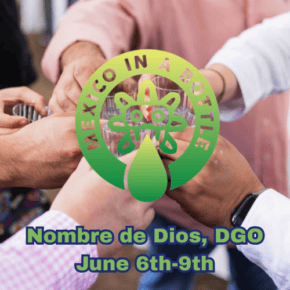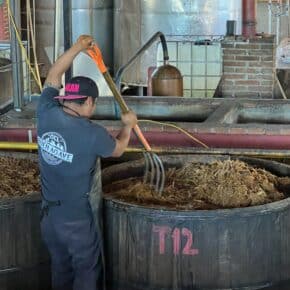Recently Mezcal PhD sounded off about the Bacardi/Zignum tie up. Susan and I share the same opinion about the entire deal: it’s a mass-produced drink made for a massive liquor distribution pipeline. It’ll be primarily used for cocktails or shots, and that’s the best use for it because it’s not worth sipping. Such is the nature of globalized capitalism. Companies focus on expanding market share. They’ll do that simply by branding.When they actually have to make something, they’ll look for a product already in the market that they can inject into their distribution pipeline.
The latter just occurred with Zignum. This is what happens when global commodity capitalism encounters a traditional product: Scale it up to an industrial scale, pump it into massive distribution pipelines, and sell as much as possible. This isn’t necessarily a negative interaction, it can introduce new flavors and ideas to the wider world, provide critical income to the people who actually make the products, and maintain the very tradition at its base. Take a look at many successful European products like prosciutto and parmeggiano. They’re mass-marketed, but the critical differences are that the producers are compensated fairly, the natural resources are managed, not exploited, and the production cycle is vastly different. But the process does have to be managed so that global capital doesn’t annihilate the local system. Simply put the problem is sustainability; economic, cultural, and environmental.
One of the huge issues in Oaxaca and among mezcal producers across Mexico is that small and medium-sized businesses aren’t set up to take over the industry. Europe had a fantastic confluence of trade groups, labor, capital, and political interests which helped define and sustain a culture of small businesses that built and still provide an incredible level of employment, maintenance of artisanal traditions, and the national culture. There are problems, but by and large the entire approach has been incredibly successful.
Not so in Mexico where products like tequila have been industrialized at the expense of the original artisanal product, the environment, and the web of labor and capital around it. Meanwhile incipient industries like mezcal seem like they’re going to get the same treatment. Local mezcal producers known as palenqueros are largely shut out of the critical product certification processes while international investors have stepped in to pay their way through the legal hoops. Local entrepreneurs are in the same position, capital is hard to come by locally, the regulatory environment is titled greatly in favor of larger enterprises, and then they have to figure out how to export. Is it any wonder that many mezcal producers remain in the grey market?
To turn this around, look at the resource potential in Oaxaca and elsewhere, they have an entire spirits industry ready to do double duty as international export and anchor for gastrotourism. Already tons of bartenders, chefs, and culinary types make the trip down to Oaxaca to visit palenques and see the mezcal production process. It’s magic in a bottle and they want to be associated with that. I haven’t seen a good value figure for this, but we know so many people already making a go of it that it seems fairly self evident that fostering small and medium-sized businesses would spread the benefits around and contribute to stable economic development that would deliver consistent benefits for generations. It could be another critical chapter in the Mexican export and tourism brand.
It’s all too easy to critique from the outside but the simplest things imaginable like a trade group that acts in small and medium sized mezcal makers’ interests would be a start. To date COMERCAM, the Mexican regulatory group set up to certify mezcal, has been at best ineffective, at worst acting against small and medium enterprises. Meanwhile the clock is ticking at every point in the production process. Many palenqueros are aging and their knowledge may disappear with them since the economics of the business don’t currently encourage kids to join. Western consumers who look to definitional experiences to introduce them to new products have almost forgotten the previous negative reputation of mezcal as a spring break drink defined by a worm in the bottle and the mythos of hallucinatory effects. If they’re burned twice by low quality products they won’t return any time soon. Local Mexican industries can only gain so much from the complete commodification of a product, they need the higher end products to create a truly sustainable industry. And then there are the massive environmental issues, which may be the true existential time bomb.
For a while now in Oaxaca quality hardwood has been more expensive than agave because it’s in such short supply and consumed so quickly by palenqueros. That’s led to positive experiments that look to the future like Fidencio’s sin humo mezcal, and to the past with some palenqueros using more of the dried agave stalks and leaves to fire their pits. But rumors are also rampant that unscrupulous palenqueros are using railroad ties and tires to cook agaves. No one has proved it yet, but the whispers have been around for years so at best it’s a very worrisome trend. This line of discussion doesn’t even include the so-called environmental externalities, the fact that burning all that wood to make mezcal contributes to global warming while degrading air quality and increasing local health problems.
Then there are the hidden costs of a lack of effective regulation: For some time we’ve been hearing about truckloads of agave hearts being sent north from Oaxaca to Jalisco to be blended into tequila or simply discarded. It’s a critical issue, if the local and national authorities can’t manage their extremely valuable natural resources then more unscrupulous actors will exploit it for them and potentially destroy most elements of value. If nothing is done rising local unemployment will only increase while the lack of local ownership will decrease along with the amount of money flowing through the local economy. Without those elements the economic poverty endemic to rural Mexico can only increase, and immigrants to major cities and abroad will continue both depriving the country of intellectual and economic benefits. Everyone loses. We’ve covered one of the bright points with Tosba’s crew of immigrants to the US investing in their pueblo’s mezcal production. It’s a fantastic example of what can be achieved but it’s one of few. The bigger picture isn’t as illuminating, it needs to be much more organic and self sustaining.
Then there’s the agave production issue, given the time to produce a distillable fruit and the fact that you get exactly one shot at using the fruit there are tremendous natural pressures that can’t be resolved through the normal response of scaling agriculture to industrial levels. The tequila industry has done this by focusing on monoculture but that frequently opens it up to periodic waves of disease and infestation. And then there’s not a ton of arable land for agave, it’s not clear that this is the best use of the land, and it could easily find mezcal in the same position of tequila, that is, a product tailored to a single agave which doesn’t express the wonders of the diversity in the world of mezcal. This is the critical issue that most consumers don’t understand and the industry doesn’t control for. Just to be clear, every other distillate in the world comes from a reproducible resource, grappa comes from grapes grown on vines that can produce for decades, whiskeys are made from corn and grains produced in annual crops while fruit brandies come from fruit trees that produce for at least decades, sometimes longer. Given that limitation agave distillates should probably be priced much higher. The fact that most tequilas cost less than $50 and most mezcals less than $100 is a testament to the price of labor in Mexico and the undervaluing of Mexican agave.
To top it all off there’s the issue of tradition or cultural sustainability. Mezcal is a critical element of Oaxacan traditions and occupies a similar role in many areas of Mexico. It’s an integral thread of the cultural fabric still produced for weddings and parties which are the core to local social life. Mexican distilling has been both solitary and communal, an expression and container of traditions going back hundreds of years. It sustains those traditions while also intersecting with greater market forces. At the very least it’s worth fighting for mezcal’s continued artisanal sustenance just to ensure that Mexican cultures continue to thrive. That’s vital for the maintenance of the local social structure and everything else that comes along with it, it’s why tourists visit, and it’s the narrative that is used to sell mezcal.
That’s a sketch of the real threats behind the industrialization of mezcal. The dangers are more than real, they have already been realized and it’s more a question of whether regulators can resist the siren call of fast money massive scale in favor of the more difficult path to an economically and culturally sustainable industry . None of this is to say that I, Susan or you should reject industrialized mezcal out of hand. I can easily imagine a scenario where better than decent mezcal is produced at scale, where agaves are cultivated without depleting wild stocks, where damage to the environment is minimized, and where the farmers and producers are an integral part of the process. I just don’t want to erase the place, the people, and the original idea of traditional mezcal. That has to be part of the bargain.













Very good clarification of the issues at hand. I appreciate your thorough consideration of the topic as it applies to conditions and principles which influence the balance between economies of scale and preservation of artisanal-independent business—ecological and health conditions included.
As with all industrious pursuits which survive disease, roots must be strong and run deep. Thorns provide a stoop for pollinators and a prick to invasive species. The answers are clear to those who study systems design.